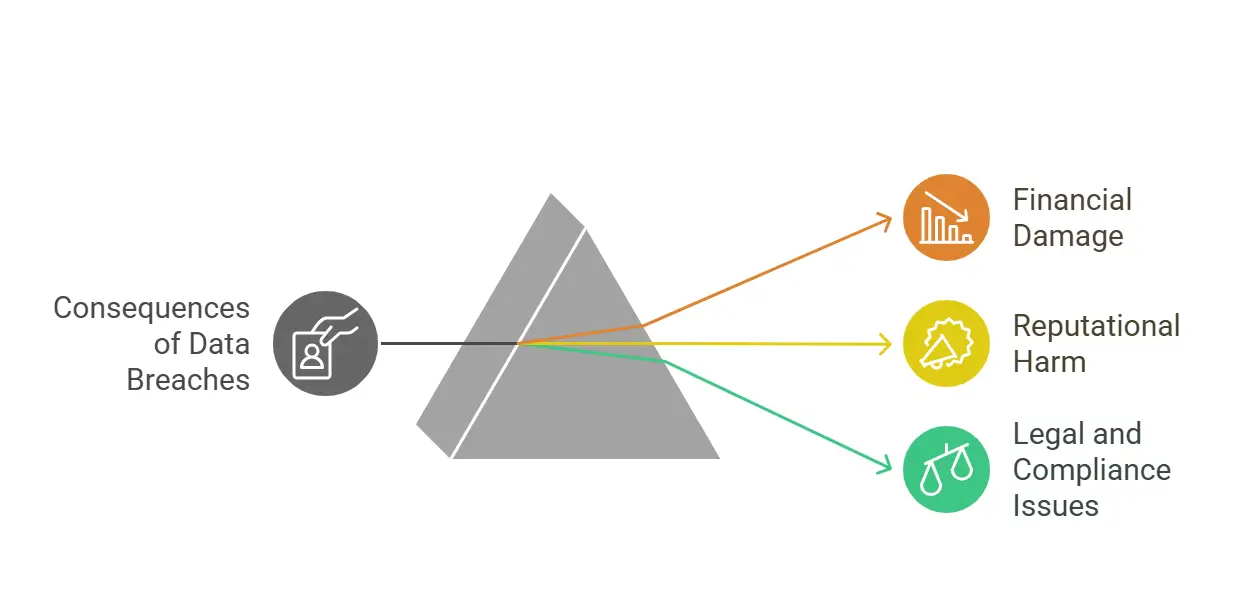Cyberattacks have grown more aggressive, exposing businesses to costly risks. In the third quarter of 2024, data breaches globally revealed over 422 million records. Every exposed record carries financial, legal, and reputational consequences.
As Charles Bender, CEO of Attentus Technologies, says, “Businesses can’t afford to react to cybersecurity threats. Prevention is the only strategy that works in today’s high-risk digital environment.“
If security threats seem distant, think again. Organizations of all sizes are vulnerable. Examining major data breaches and their impact can help you take action before your company is the next victim.
Secure Your Business Against Cyber Threats with Proven ProtectionEliminate security gaps, enforce compliance, and prevent cyber threats before they disrupt your operations. |
How Major Data Breaches Happen
Cybercriminals exploit weaknesses that businesses fail to address. Attacks often start small, but their impact is devastating.
- Weak Passwords and Poor Authentication: Many breaches occur because employees use weak passwords or companies fail to enforce multi-factor authentication (MFA).
- Phishing Attacks: Attackers use deceptive emails to steal credentials. These are among the most common entry points for cybersecurity breaches.
- Unpatched Software and Outdated Systems: Failing to apply security updates leaves systems vulnerable to known exploits.
- Insider Threats: Employees and contractors with access to sensitive data can expose it through negligence or malicious intent.
- Third-Party Risks: Suppliers and service providers with weak security become backdoors for attacks.
Recognizing these risks is the first step. Strengthening security practices is the next. Let’s take some lessons from some of the most recent data breaches.
Recent Data Breaches and Their Impact
The past few years have seen several high-profile cyber incidents, reinforcing the need for businesses to strengthen their security.
Here are some of the most significant recent breaches:
1. T-Mobile (2023)
Hackers exploited an API vulnerability, compromising the personal data of 37 million customers. This breach exposed names, addresses, phone numbers, and account details, raising concerns about API security and data protection measures.
2. DarkBeam Credential Leak (2023)
Security researchers discovered that DarkBeam, a cybersecurity intelligence firm, had exposed over 3.8 billion records containing email addresses, passwords, and other sensitive data. The incident underscored the dangers of misconfigured databases and poor access controls.
3. 23andMe (2023)
A credential-stuffing attack exposed the genetic and personal data of thousands of users. Hackers leveraged reused passwords from previous breaches, demonstrating the ongoing risks of weak password security.
4. Latitude Financial (2023)
A cyberattack on the Australian financial services firm resulted in the theft of over 14 million customer records, including passport numbers, driver’s license details, and financial information.
The breach led to regulatory scrutiny and increased pressure for improved financial cybersecurity standards.
Notable Data Breach Examples That Shook Industries
Cyber incidents reveal weaknesses that businesses often overlook. Examining famous data breaches reveals how a single vulnerability can lead to massive financial, legal, and operational consequences.
1. Equifax Data Exposure (2017)
A failure to patch a known software vulnerability led to the exposure of personal data from 147 million people.
Attackers exploited an unpatched web application, gaining direct access to sensitive financial records. The company faced lawsuits, regulatory fines, and a damaged reputation. This breach emphasized the importance of proactive vulnerability management.
2. Marriott International Data Breach (2018)
Attackers exploited security gaps in a system inherited from a company Marriott acquired. The breach remained undetected for four years, exposing records from 500 million customers.
Weak security in third-party and acquired systems played a key role, highlighting the need for rigorous security audits during mergers and acquisitions.
3. MOVEit Supply Chain Attack (2023)
Hackers exploited a vulnerability in the MOVEit file transfer software, affecting hundreds of businesses that relied on the service.
Attackers stole sensitive data from multiple organizations, showing how supply chain security gaps can lead to widespread data exposure. This case reinforced the importance of vendor risk management and software security assessments.
These cyber incidents prove that no industry is immune. Protecting data requires continuous monitoring, fast response to vulnerabilities, and strict security controls.
The Real-World Data Breach Consequences
Cyber incidents don’t just expose data; they disrupt businesses, damage reputations, and trigger costly legal battles.
The financial and operational fallout from these breaches proves that weak security comes at a steep price. Here’s how real-world incidents have impacted organizations across industries.
Financial Damage
The financial impact of a breach is staggering. IBM’s 2024 Cost of a Data Breach Report found that the average cost of a data breach reached $4.88 million in 2024. Businesses face regulatory fines, class-action lawsuits, and compensation claims from affected customers.
The cost of recovery includes incident response, forensic investigations, and public relations efforts to manage the crisis. Additional security upgrades, new compliance measures, and lost productivity further escalate expenses. For small and midsized businesses, these costs can be crippling.
Reputational Harm
A data compromise can permanently damage customer trust. Consumers are less likely to do business with an organization that has mishandled their personal information. Negative media coverage and public backlash amplify the damage.
A single incident can take years to recover from, with declining customer retention and lost revenue opportunities. Even long-standing brands can struggle to restore their reputation after a breach.
Legal and Compliance Issues
Regulatory bodies enforce strict penalties on businesses that fail to protect sensitive data. Laws like GDPR, CCPA, and HIPAA require organizations to report breaches and provide protection for customer data.
Failing to comply results in heavy fines and legal scrutiny. Additionally, companies that neglect security best practices may be held liable for negligence, leading to expensive lawsuits. Breaches involving sensitive personal or financial data attract even more regulatory action, forcing businesses to implement costly compliance overhauls.
| More articles you might like |
Preventing Data Breaches With Smarter Security Measures
According to CloudSecureTech, global expenditure on data security has climbed to $81.6 billion. There is no foolproof way to eliminate attacks, but strong security practices significantly reduce the likelihood of a breach.
Here are data breach prevention tips you should implement:
- Strengthen authentication measures: Require multi-factor authentication (MFA) for all users. Use password managers to enforce strong, unique passwords.
- Train employees on cybersecurity best practices: Conduct regular phishing awareness training. Restrict access to sensitive data based on job roles.
- Secure systems with regular updates: Patch software vulnerabilities as soon as updates are released. Use endpoint protection to monitor for suspicious activity.
- Protect data with encryption: Encrypt sensitive data at rest and in transit. Implement strict access controls to limit decryption.
- Strengthen third-party security controls: Vet all vendors and enforce strict security policies. Regularly audit third-party security practices.
Cyber threats evolve, but these data protection strategies create strong defenses against attacks.
Key Takeaways and Actionable Steps
Every business is at risk. No organization is immune if major data breaches affecting global corporations can happen.
- Weak passwords, phishing attacks, and outdated software make companies easy targets.
- Data breach consequences include financial losses, legal action, and reputational harm.
- Implementing data breach strategies like MFA, employee training, and encryption reduces risks.
Cybersecurity requires ongoing effort. The right security measures today can prevent a crisis tomorrow.
Cybersecurity Practices to Reduce Data Breach Risks
Businesses often overlook key security measures that could prevent breaches. Here’s a breakdown of essential cybersecurity practices and their benefits:
| Cybersecurity Practice | Benefit |
| Multi-Factor Authentication (MFA) | Blocks unauthorized access even if credentials are stolen. |
| Zero Trust Security Model | Limits access based on need-to-know permissions, reducing internal threats. |
| Security Information and Event Management (SIEM) | Detects and responds to threats in real-time. |
| Dark Web Monitoring | Alerts businesses if employee credentials are leaked online. |
| Regular Security Audits | Identifies weaknesses before attackers exploit them. |
Every business should integrate these security practices to strengthen defenses against data breach vulnerabilities.
Secure Your Business Against Cyber Threats with Reliable Protection
Cyber threats aren’t slowing down. Attacks are growing more sophisticated, and businesses must stay ahead.
Attentus Technologies provides expert cybersecurity services that safeguard your systems from major data breaches. With over 22 years in business and a 98.4% customer satisfaction rating, our team delivers security solutions that reduce risks and strengthen defenses. One of our core values is ‘Be the Answer,’ ensuring we provide reliable expertise with no hidden costs—thanks to our fixed rates. We also maintain a 10-year client retention rate and resolve common security and compliance issues in just 15 minutes, giving you fast, effective protection.
| Discover Advanced Cybersecurity Services Across the Pacific Northwest | ||
|---|---|---|
| Bellevue | Seattle | Tacoma |




